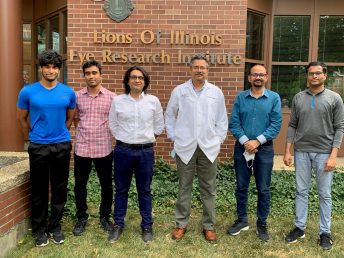Researchers identify protein that prevents serious brain damage, reduces risk of fatal HSV-1 infection
A new study by University of Illinois Chicago researchers shows a mechanism that stops the herpes simplex virus 1 from causing serious brain damage and death.
Researchers discovered a function of a protein complex, mammalian target of rapamycin complex 2, in an antiviral defense mechanism. This protein complex limits HSV-1 virus infection through rapid activation of antiviral immunity and protects the host by preventing encephalitis — brain inflammation — and possible death due to HSV-1 infection.
The paper, “mTORC2 confers neuroprotection and potentiates immunity during virus infection,” was published recently in the journal Nature Communications. The research was performed by UIC researchers in the laboratory led by Deepak Shukla, the Marion H. Schenk Esq. Professor in Ophthalmology for Research of the Aging Eye, and vice chair for research at UIC.

From left: mTORC2 researchers Raghuram Koganti, Krishnaraju Madavaraju, Tejabhiram Yadavalli, Deepak Shukla, Chandrashekhar Patil and Rahul Suryawanshi.
Ocular herpes infection is a leading cause of infectious blindness and can lead to lethal brain infections. After a primary infection, HSV-1 hides in neuronal tissues and reactivates under immune suppressive conditions that may cause encephalitis, leading to permanent brain damage, memory loss or even death. Herpes is a common infection, even in healthy individuals, and is rarely lethal. To understand how antiviral defense mechanisms could work, UIC researchers studied mTORC2, Shukla said.
Using genetically modified mice models, researchers uncovered the importance of mTORC2 in activation of innate- and virus-adaptive immunity during ocular HSV-1 infection.
“Animals with a lack of functional mTORC2 were found to show significant loss of immune activation and more spread of virus to neuronal tissues,” Shukla said. “Functional mTORC2 limits the virus spread from ocular to neuronal tissues by supporting the production of antiviral cytokines and driving immune cells to quickly identify HSV-1 infected cells. MTORC2 also protects the ocular and neuronal cells from virus-induced cell death offering protection to neuronal tissue,” Shukla said.
In order to combat lifelong HSV-1 infection, it is essential to uncover the role of key cellular proteins and modulate their function to stop the virus from replicating and causing damage, explained Rahul Suryawanshi, the study’s lead author, a former postdoctoral trainee of Shukla, now at the Gladstone Institutes, San Francisco. During herpes infection, mTORC2 activates cell survival machinery in ocular and neuronal tissues. This restricts a programmed cell death mechanism, which limits virus spread but, at the same time, is detrimental to neuronal cells, Suryawanshi said.
“The animal experiments highlight the importance of using neuronal cell death inhibitors during viral encephalitis that may mimic and/or improve mTORC2 functions and prevent brain injuries,” said Chandrashekhar Patil, a co-author of the study and a visiting scholar at UIC’s department of ophthalmology and visual sciences.
Shukla said the study explains that the pro-survival functions of mTORC2 may not be limited to viral infections. They are likely to be applicable to many other diseases.
“Our study will motivate other researchers to investigate mTORC2 in neurodegenerative disorders and diseases as well,” Shukla said.
Additional authors are Alexander Agelidis, Raghuram Koganti, Joshua M. Ames, Lulia Koujah, Tejabhiram Yadavalli, and Krishnaraju Madavaraju, all of UIC, and Lisa M. Shantz of the University of Connecticut.
This research was supported by the National Institutes of Health and National Eye Institute grants (EY029426, AI139768, EY024710, EY001792) and Illinois Society for Prevention of Blindness.
